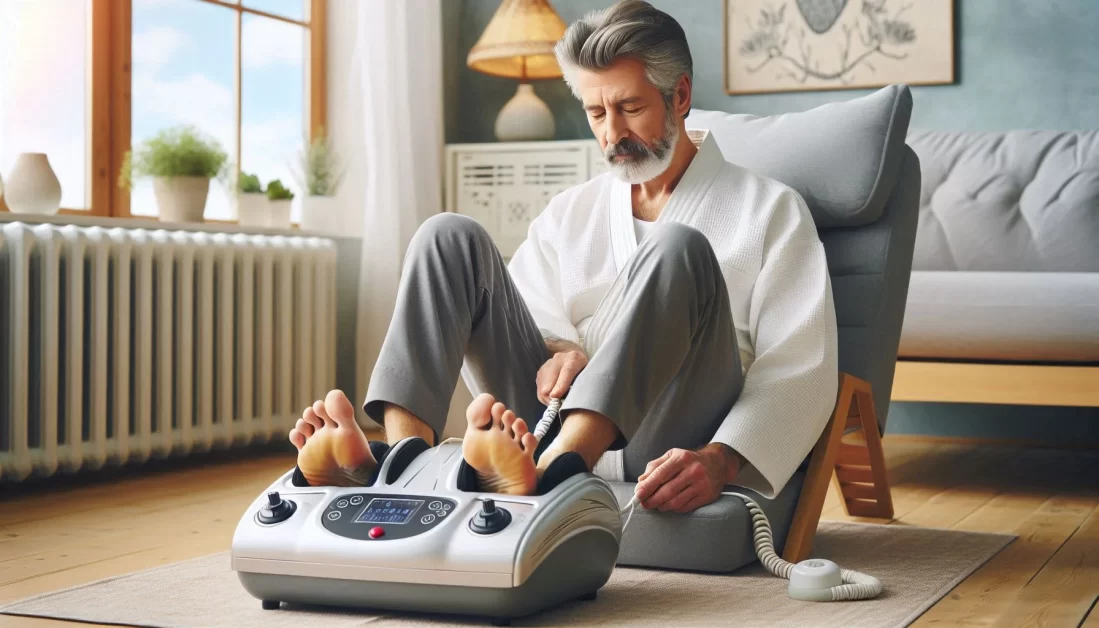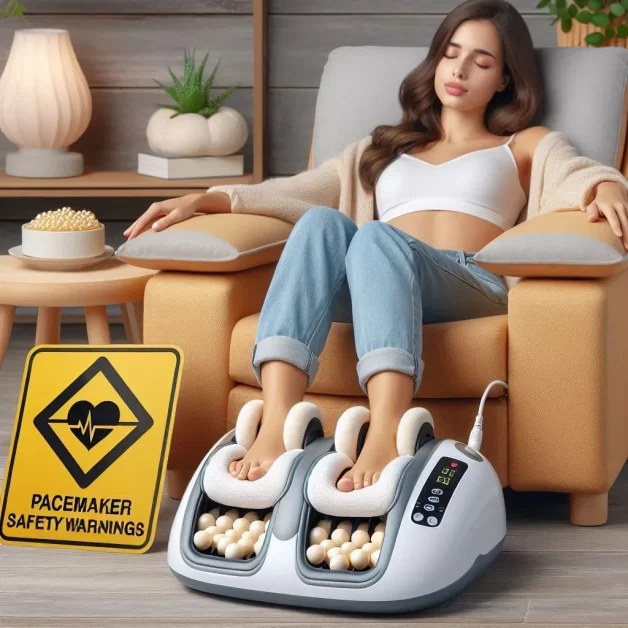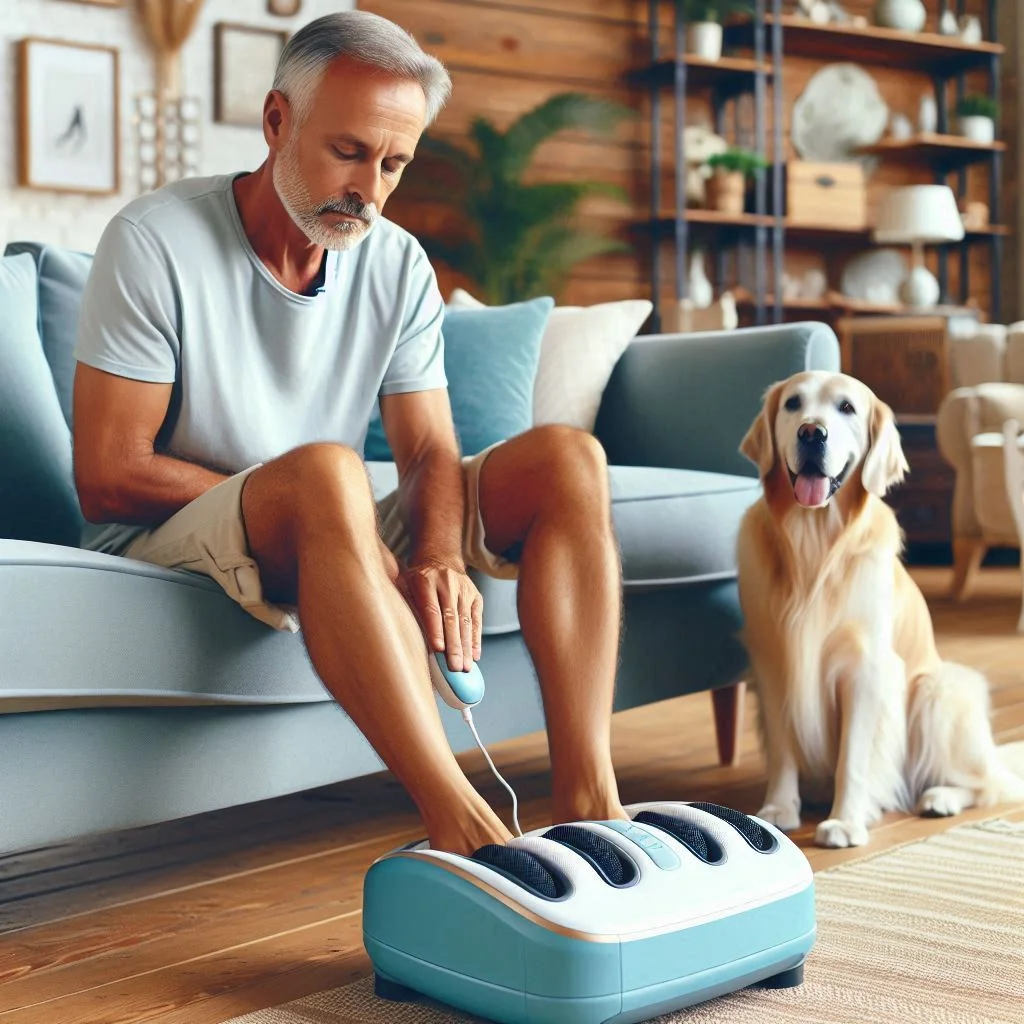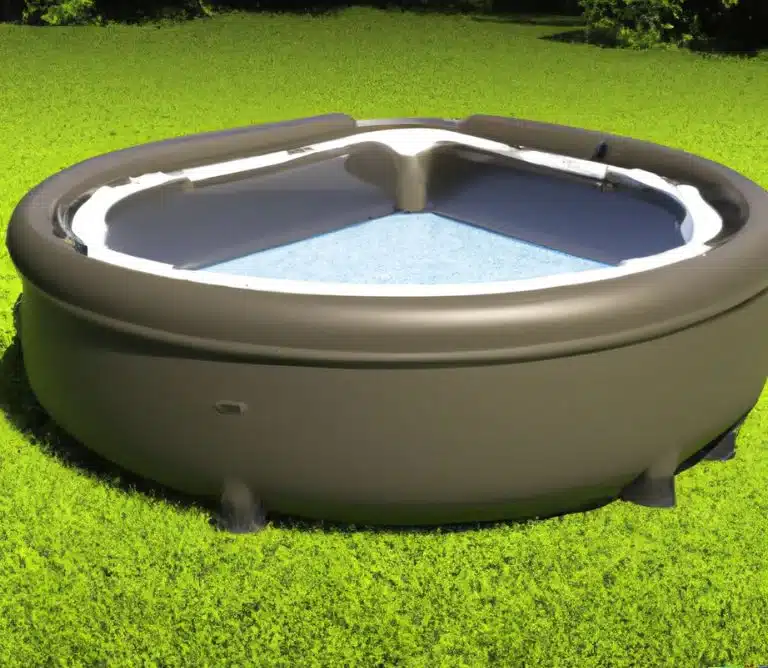Shiatsu Foot Massager and Pacemaker Safety
Learn about the safety of using shiatsu foot massagers if you have a pacemaker. Understand the risks of electromagnetic interference (EMI) and get advice on consulting your doctor for personalized guidance. Stay safe with expert tips from Hot Tub Patio.
If you have a pacemaker and want to use a shiatsu foot massager, it’s natural to be concerned about safety. Your main worry might be the potential risk of electromagnetic interference (EMI) from the massager affecting your pacemaker’s function.
Addressing the Concern
Understanding EMI
Understanding EMI and its potential impact is crucial for pacemaker users, as it highlights the importance of avoiding sources of strong electromagnetic fields and consulting healthcare providers before using new electronic devices.
What is electromagnetic interference (EMI)?
Electromagnetic interference (EMI) is a disturbance generated by an external source that affects an electrical circuit through electromagnetic radiation or conduction. This interference can disrupt the normal operation of electronic devices, causing them to malfunction.
How can EMI potentially impact the function of pacemakers?
- Signal Disruption: Pacemakers rely on precise electrical signals to maintain the heart’s rhythm. EMI can disrupt these signals, leading to improper pacing or irregular heartbeats.
- Device Malfunction: In some cases, strong electromagnetic fields can cause the pacemaker to interpret false signals, resulting in inappropriate pacing responses or temporarily disabling the pacemaker’s functions.
- Interference Threshold: Different pacemakers have varying thresholds for EMI tolerance. If the EMI exceeds this threshold, it can interfere with the pacemaker’s ability to function correctly, potentially posing a serious health risk.
Check out our guide to Using an Electric Massager with a Pacemaker: Essential Tips You Need to Know

EMI and Foot Massagers
Some studies have shown that the risk of EMI from foot massagers is limited. These studies suggest that the low levels of EMI emitted by most household electronic devices, including foot massagers, are generally safe for people with pacemakers. However, it is crucial to remember that individual cases can vary based on the model of the pacemaker and the user’s medical history.
[wps_alert type=”warning”]Key Point: Always consult your doctor or cardiologist before using a foot massager. This is essential because:[/wps_alert]
- Pacemaker Models: Different models have different levels of susceptibility to EMI.
- Medical History: Your unique medical history and condition might affect how your pacemaker interacts with other devices.
Why is it important to consult a doctor or cardiologist before using a foot massager if you have a pacemaker? ChatGPT
It is important to consult a doctor or cardiologist before using a foot massager if you have a pacemaker for several reasons:
- Pacemaker Variations: Different pacemaker models have varying levels of susceptibility to electromagnetic interference (EMI). A doctor can determine how your specific pacemaker model might interact with the foot massager.
- Medical History: Your unique medical history and condition can influence how your pacemaker responds to external devices. A healthcare professional can provide personalized advice based on your overall health and any underlying conditions.
- Safety Assurance: Consulting a doctor ensures that using the foot massager won’t negatively affect your pacemaker’s function, helping to prevent any potential health risks.
- Professional Guidance: A cardiologist can offer recommendations and safety practices tailored to your situation, ensuring you use the device safely and effectively.
Why might there be a risk of electromagnetic interference (EMI) from the massager affecting the pacemaker’s function?
There might be a risk of electromagnetic interference (EMI) from the massager affecting the pacemaker’s function because:
- EMI Emission: Electronic devices, including shiatsu foot massagers, can emit electromagnetic fields as part of their normal operation. These fields can potentially interfere with the electrical signals that pacemakers rely on to regulate heart rhythm.
- Signal Disruption: Pacemakers use precise electrical signals to control heartbeats. If EMI disrupts these signals, it could cause the pacemaker to malfunction, leading to irregular heartbeats or other cardiac issues.
- Proximity and Intensity: The risk of interference depends on the strength of the electromagnetic field and the proximity of the massager to the pacemaker. Closer proximity and higher-intensity fields increase the likelihood of interference.
- Device Sensitivity: Some pacemakers are more sensitive to EMI than others. Factors such as the pacemaker’s design, shielding, and the specific frequency of the emitted electromagnetic field can affect its vulnerability to interference.
What do studies say about the risk of EMI from foot massagers?
Studies suggest that the risk of electromagnetic interference (EMI) from foot massagers is generally low. Most household electronic devices, including foot massagers, emit low levels of EMI that are unlikely to affect the function of pacemakers. Further, individual experiences can vary; certain conditions might increase susceptibility to interference.
Why is it important to consult a doctor or cardiologist before using a foot massager if you have a pacemaker?
- Customized Advice: A doctor or cardiologist can provide personalized guidance based on your specific pacemaker model and overall health condition.
- Safety Assurance: Consulting a healthcare professional helps ensure that using a foot massager won’t negatively impact your pacemaker’s function, thereby preventing potential health risks.
- Risk Assessment: A medical professional can evaluate the specific risks associated with your pacemaker and the type of foot massager you plan to use.
What variations in pacemaker models might affect their susceptibility to EMI?
- Design Differences: Pacemakers have different designs and shielding, which can affect their resistance to EMI.
- EMI Tolerance: Some models are built with higher thresholds for tolerating electromagnetic fields, while others might be more sensitive.
- Frequency Response: Pacemakers vary in how they respond to different frequencies of electromagnetic fields. Some might be more susceptible to interference at certain frequencies emitted by foot massagers.
How can an individual’s medical history influence the interaction between their pacemaker and a foot massager?
- Underlying Health Conditions: Conditions like heart disease, arrhythmias, or other cardiovascular issues might make a person more vulnerable to pacemaker interference.
- Medication and Treatment: Current treatments and medications might interact with the pacemaker’s function and its susceptibility to EMI.
- Previous Experiences: Any past incidents of pacemaker malfunction or EMI sensitivity should be considered when evaluating the safety of using a foot massager.

Additional Information
If your doctor approves the use of a shiatsu foot massager, here are some safety practices to keep in mind:
- Follow Manufacturer Guidelines: Always use the foot massager according to the manufacturer’s instructions.
- Maintain Distance: Try to keep the massager at a reasonable distance from your chest where your pacemaker is located.
- Monitor Your Health: Pay attention to any unusual symptoms or feelings while using the massager. If you experience any issues, stop using it immediately and contact your doctor.
Additional Information
What safety practices should be followed if a doctor approves using a shiatsu foot massager?
- Follow Manufacturer Guidelines: Always adhere to the instructions the massager’s manufacturer provides.
- Maintain Distance: Keep the massager away from your chest where your pacemaker is located to reduce the risk of EMI.
- Use in Short Sessions: Start with short sessions to monitor any adverse effects before increasing usage time.
- Avoid High-Intensity Settings: Use the massager on lower settings to minimize potential interference.
- Regular Check-ups: Schedule regular check-ups with your doctor to ensure your pacemaker functions correctly.
Why is it important to follow the manufacturer’s guidelines?
Following the manufacturer’s guidelines ensures you use the device safely and as intended. These guidelines are designed to minimize risks and ensure optimal performance, helping to prevent potential EMI that could affect your pacemaker.
How can maintaining a distance between the massager and the pacemaker help?
Maintaining a distance between the massager and the pacemaker reduces the risk of electromagnetic fields reaching and interfering with the pacemaker’s operation. This is a simple but effective way to minimize the chances of EMI affecting your device.
Why should users monitor their health while using the massager?
Users should monitor their health to detect any unusual symptoms or changes in their feelings. Immediate discontinuation of the massager and consultation with a doctor, if any issues arise, is crucial for preventing potential adverse effects on the pacemaker’s function.
Where can users find more information on pacemakers and EMI?
Users can find more information on pacemakers and EMI from reputable medical and health organizations offering comprehensive resources and guidelines.
[wps_alert type=”primary”]Remember, your health and safety come first. Always prioritize professional medical advice over general guidelines.[/wps_alert]
Who Should Not Use Foot Massagers?
- Individuals with Specific Health Conditions:
- Pacemaker Users: Unless explicitly approved by a doctor, individuals with pacemakers should be cautious due to the risk of electromagnetic interference (EMI).
- Diabetics with Neuropathy: Those with diabetic neuropathy might not feel the intensity properly and could inadvertently cause injury.
- Pregnant Women: They should consult their doctor as some pressure points might induce contractions.
- Individuals with Circulatory Issues: Those with conditions like deep vein thrombosis (DVT) or severe varicose veins should avoid using foot massagers to prevent exacerbating their conditions.
- Recent Surgery Patients: People recovering from foot or leg surgeries should avoid using foot massagers until fully healed and cleared by their doctor.
- People with Skin Conditions:
- Individuals with skin infections, open wounds, or severe skin conditions on their feet should avoid using foot massagers to prevent further irritation or infection.
What equipment should we avoid for patients who have a pacemaker?
1. High-EMI Devices:
- Magnetic Resonance Imaging (MRI): MRI machines generate strong magnetic fields that can interfere with pacemakers.
- Electrocautery Devices: Commonly used in surgeries, these can generate significant electromagnetic interference.
- TENS Units: Transcutaneous electrical nerve stimulators (TENS) can produce electrical currents that may disrupt pacemaker function.
2. Household and Office Equipment:
- High-Power Tools: Equipment like drills, welding machines, and chainsaws can emit substantial EMI.
- Large Motorized Appliances: Items such as refrigerators and washing machines should be used with caution and kept at a safe distance.
- Metal Detectors: Used in airports and security checkpoints, these can interfere with pacemakers and should be avoided or used under special conditions with medical documentation.
3. Communication Devices:
- Certain Mobile Phones and Tablets: While most modern devices are safe, keeping them away from the chest area and using them with caution is recommended.
- Walkie-talkies and Ham Radios can emit strong electromagnetic fields that may interfere with pacemakers.
Other Medical Equipment:
- Radiation Therapy Machines: Used for cancer treatment, these machines can disrupt pacemaker function.
- Diathermy Machines: Used for therapeutic heating, diathermy machines can cause interference with pacemakers.
Check out Devices that May Interfere with ICDs and Pacemakers on heart.org
[wps_alert type=”note”]Always consult with a doctor or cardiologist to determine safe practices and equipment use, ensuring that your pacemaker operates without interference. Professional medical advice is essential for those considering foot massagers or any other electronic devices to prevent any potential health risks.[/wps_alert]

Understanding Warnings for Leg Air Massagers
Warnings on leg air massagers and electric foot massage machines are crucial for safeguarding users with specific health conditions. Individuals with pacemakers, AFib, circulatory issues, or recent surgeries should always consult their doctor before using these devices to ensure safety and prevent potential health risks.
Why is there a warning in a leg air massager not to use it with certain health conditions?
Leg air massagers come with warnings because they can affect circulation and exert pressure, which might be harmful in certain health conditions. The warnings ensure that users are aware of potential risks, particularly for individuals with the following conditions:
- Circulatory Problems:
- Deep Vein Thrombosis (DVT): Using a leg air massager can dislodge blood clots, leading to serious complications like pulmonary embolism.
- Severe Varicose Veins: Increased pressure from the massager can worsen the condition or cause pain.
- Cardiovascular Conditions:
- Pacemakers: The electrical components might interfere with the device, affecting its function and posing a health risk.
- Atrial Fibrillation (AFib): People with AFib should be cautious, as changes in blood flow or pressure might trigger arrhythmias.
- Skin Conditions and Injuries:
- Open Wounds or Infections: The massager could aggravate the condition or lead to further infection.
- Sensitive Skin: Individuals with sensitive skin conditions might experience irritation or damage from the massager’s pressure.
- Recent Surgery:
- Post-operative patients, especially those recovering from leg or vascular surgeries, should avoid using such devices until fully healed and cleared by a doctor.
Is an Electric Foot Massage Machine Safe for AFib Patients?
Electric foot massage machines can pose risks for AFib patients due to the following reasons:
- Electromagnetic Interference (EMI): Some foot massagers generate electromagnetic fields that might interfere with pacemakers or other implanted cardiac devices, potentially leading to malfunctions.
- Blood Flow Changes: The massage could alter blood flow and pressure, triggering arrhythmias or exacerbating existing heart conditions.
- Stimulation of Pressure Points: Certain pressure points might induce unwanted cardiovascular responses, especially in individuals with AFib or other heart conditions.
What are some reputable resources for additional information?
- American Heart Association (AHA): American Heart Association
- Mayo Clinic: Mayo Clinic
- National Heart, Lung, and Blood Institute (NHLBI): NHLBI
- Medtronic (Pacemaker Manufacturer): Medtronic
- Boston Scientific (Pacemaker Manufacturer): Boston Scientific.
- Safety of electronic massagers in patients with cardiac implantable electronic devices: https://pubmed.ncbi.nlm.nih.gov/33118195/
These resources provide detailed information on pacemakers, EMI, and best practices for device users.
Final Thoughts
Understanding the risks and precautions associated with using a shiatsu foot massager is crucial for individuals with pacemakers. Always consult your doctor or cardiologist to ensure your pacemaker’s safety and proper functioning. For more outdoor living relaxation and wellness tips, visit Hot Tub Patio, your ultimate source for creating an oasis of tranquility at home.










